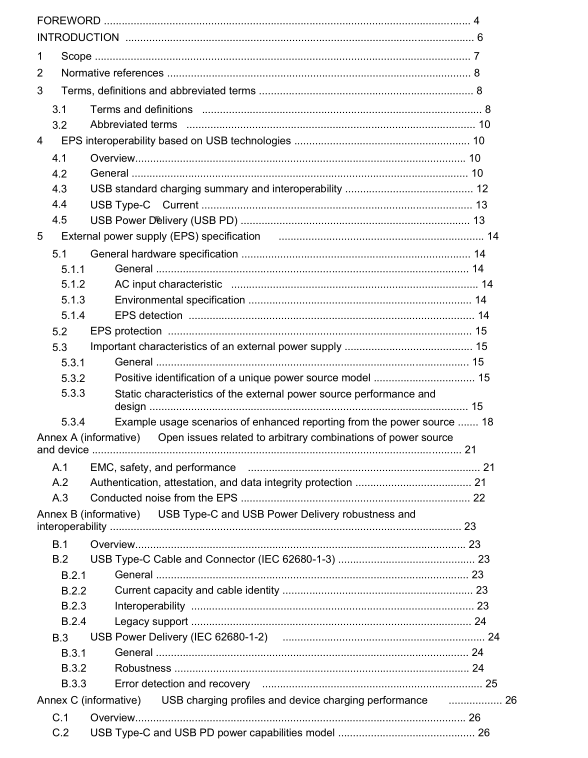IEC 63002 pdf – Interoperability specifications and communication method for external power supplies used with computing and consumer electronics devices

IEC 63002 pdf – Interoperability specifications and communication method for external power supplies used with computing and consumer electronics devices
Annex B provides further detail on the robustness and interoperability characteristics of uSBType-C and USB Power Delivery solutions.
4.4USB Type-ccurrent
The USB Type-C Current power mode is based on a regulated 5V power source with up to 3 A
operation. This power mode uses a simple analogue method over the ‘uSB Type-cConfiguration Channel (CC) interface for a Source to advertise its available current to a Sink.A uSB Type-C Source may advertise default USB Type-C Current (500 mA or 900 m4A, based
on the version of the uSB port and cable), USB Type-C Current at 1,5 A or USB Type-C Current
at 3A.An EPS shall indicate uSB BC 1.2 compatibility on the port such that a device (Sink)that doesn’t recognize USB Type-C Current modes but is compatible with USB BC 1.2 can still
draw 1,5A.
4.5USB Power Delivery (uSB PD)
Power transfer at other than 5V or over 3 A shall comply with EC 62680-1-2 (USB PowerDelivery). USB Power Delivery standardizes the discovery,configuration and functionaloperation of more capable USB Type-C power sources and battery chargers. The USB PDprotocol,operating as a digital communication over the USB Type-c CC interface,enables apredictable,reliable user experience based on a common set of robust mechanisms andcommunication exchanges between the USB Source and the Sink. The comprehensive set ofpower delivery methods supported by the USB PD protocol enables a broad range of batterycharging approaches and profiles that are specific to the design and operation of the devicebeing charged (the Sink) – this enables device designs to evolve and innovate while thecapabilities of a usB PD-based charger can remain a constant.
USB PD protocol is used to provide system control, error detection and handshaking.The fourrequired steps for enabling power delivery are:
1) Source offers its capabilities.
2)Sink requests from the offered capabilities.3) Source accepts the request.
4) Source indicates that it is ready to provide power.
USB PDprotocol can also be used for reporting the status (overcurrent protection,overtemperature protection, overvoltage protection,etc.) of the Source.
The USB PD protocol specifies two principal modes of power transfer that can be implementedby a uSB PD’Source.
– Fixed Supply operation: Provides a set of selectable fixed voltage and current combinations.
IEC 62680-i-2 defines voltages that include 5V,9V,15 V and 20 v.The Source can offeras much as 5 A, depending on the cable current rating and selected voltage.
Programmable Power Supply (PPS) operation: Provides granular control of voltage or amaximum regulated source current limit. ln PPS mode,the integrity of the connection iscontinually monitored and absence of a handshake message between Source or Sink forces
the connection to lower safe power level.PPS places the burden of regulation in the Sourceinstead of in the Sink, allowing the Sink to better manage thermal rise during higher power
battery charging,which aids in lowering touch temperatures. Standard-defined voltageranges for PPS PDOs are nominally aligned with the defined Fixed Supply PDOs (5 V,9v,
15 V and 20 V)with a range minimum of 3,3 V and maximum of 5,9 V,11V,16 V and 21 v,respectively.The Source could offer as much as 5 A, depending on the cable current ratingand selected voltage.
By default, all USB Type-C EPS are required to output power over a USB connector as a Fixed Supply capable of 5 V up to 1,5 A. USB Type-C EPS chargers can also support USB PD. USB Type-C EPSs that implement USB PD fall into one of two defined categories: a USB charger supporting only Fixed Supply operation, or a USB charger supporting both Fixed Supply and PPS operation. For both categories, charger products are required to indicate a user-visible USB PD Power (PDP) rating, which dictates the minimum set of available voltage and current ranges that a charger supports. The PDP rating, for example, which is expressed in watts ranging from 15 W to 100 W, eases user experience by matching chargers’ capabilities with device needs and also indicates expected charging performance. For any given PDP rating, the capabilities associated with all lower PDP ratings are required in the charger in order to assure safe downward compatibility with lower-power devices. See Annex C for more information. The USB Type-C and USB Power Delivery specifications will continue to evolve as data performance and power needs increase over time, supporting new product designs and technology innovations. While the USB PD protocol defines advertisement mechanisms to articulate power source capabilities of up to 50 V and 10 A, the USB Type-C connector has a practical continuous capability of 5 A.









